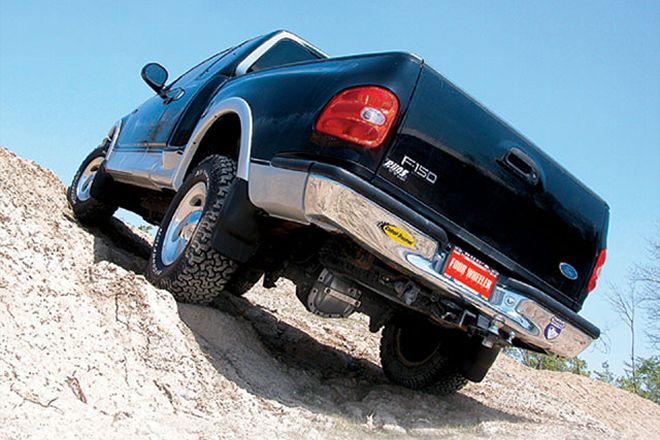
The 9.75 is a new kid on the Ford axle block. It debuted in 1997 and found a place in Ford's uprated-capacity 1/2-tons. Its primary home is in the new-generation F-150s with the higher GVW package or 5.4L V-8, but it can also be found under the '98-'02 Ford Expeditions and Lincoln Navigators. It's also been used in the limited-production 4x2 Ford SVT Lightning hot-rod pickups. There is an IRS version that replaced the beam axles in the '03-and-up SUVs.
You can see the detailed axle specs in the nearby sidebar. It's a pretty beefy axle for a 1/2-ton. Big ring gear. Big axleshafts. Stout housing. In torque capacity, it's ahead of the legendary Dana 60, though it's a bit shy of the average semi-floating D60 in load-carrying ability. When you see it, you'll say, "Ah, a downsized Sterling 10.50!" and you'd be pretty close to grasping the concept. Other notable comparisons to the Dana 60 are that the 9.75 axle has about the same-size carrier bearings and larger pinion bearings.
The 9.75 axle has had a few changes in its relatively short life, including larger axle bearings and shafts in '99 (from a 1.620-inch inner diameter to 1.705 inches), a larger outer pinion bearing (increased from 1.31 x 2.68 inches to 1.31 x 3.00 inches), and the pinion was altered for a longer crush sleeve.
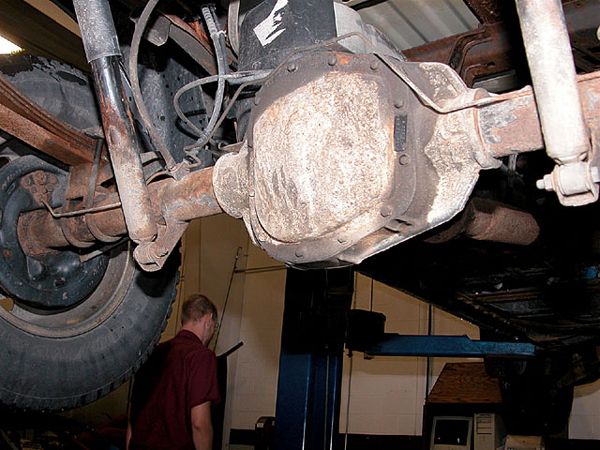 The 9.75 has a beefy centersection reminiscent of the big Ford 10.25/10.50 full-floaters. If this axle has a weak link, it's the tubes. While they are bigger in diameter than the Dana 60, they are fairly thin wall (.180-inch) compared to the D60's .250-inch...
The 9.75 has a beefy centersection reminiscent of the big Ford 10.25/10.50 full-floaters. If this axle has a weak link, it's the tubes. While they are bigger in diameter than the Dana 60, they are fairly thin wall (.180-inch) compared to the D60's .250-inch...
With the new-generation Ford F-150s outnumbering everything but corner convenience stores, we thought it useful to look at this axle from a builder's/swapper's perspective and see what can be done to make it better. To that end, we enlisted the aid of the University of Northwestern Ohio's High Performance Drivetrains class to install just about every goodie currently available for the 9.75 axle. This school is located in Lima, Ohio, and has a high-performance motorsports program beyond compare.
Our test mule was a '97 F-150 with the 5.4L V-8, 3.55:1 gears, and an open diff. With nearly stock-size tires, the owner opted to keep the stock gears, but he wanted a very streetable traction aid. Detroit's Truetrac gear-type limited-slip filled the bill in that department, and the 9.75 is a brand-new application. Eaton/Detroit Locker also makes a Detroit Locker available for the 9.75 axle.
Being known as a bit of a lead foot, and a guy who tows trailers and does a bit of mild 'wheeling, our owner wanted some extra beef. To that end, we installed a pair of stout Yukon 1541H alloy axleshafts, with new wheel bearings and seals, from Randy's Ring & Pinion. Randy's also supplied a crush-sleeve eliminator kit.
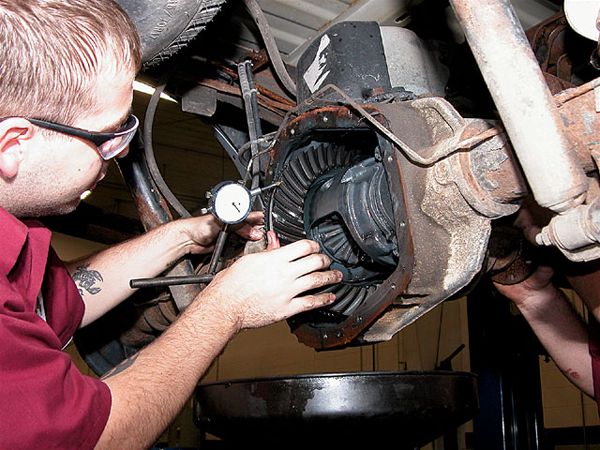 ...In strength, diameter counts for almost as much as wall thickness, but the Ford is still rated 500 to 1,000 pounds below the Dana 60's Gross Axle Weight (GAW) rating. Note the bead of welded material (arrow) that gives away the tube's HREW (Hot Rolled Electric Welded) construction.
...In strength, diameter counts for almost as much as wall thickness, but the Ford is still rated 500 to 1,000 pounds below the Dana 60's Gross Axle Weight (GAW) rating. Note the bead of welded material (arrow) that gives away the tube's HREW (Hot Rolled Electric Welded) construction.
The final building block to the 9.75 was TA Performance's diff cover/girdle. This heavy-duty 356 aircraft alloy, T-6 heat-treated aluminum cover does several things. The first is structural support for the housing in general, and carrier bearings in particular, via a pair of externally supported load bolts. Billet carrier caps are sometimes used in the same way, but it's been learned by race teams that a cap/girdle does the same thing and is easier to fit with no special machining needed.
It took a while for the aftermarket to step up to the 9.75, but in looking at its attributes, it's no wonder the Lightning boys with the older trucks and 8.8 axles are upgrading to the 9.75. The 9.75 could make a nice swap for any 1/2-ton-rated 4x4 rig, Ford or not. It has the advantage of having that "Three Bears" quality of being just right in the size and strength department to make a worthwhile improvement over the weaker 1/2-ton axles. Considering that used semi-floating Dana 60s are getting scarce, the 9.75 may become the new "junkyard D60" of the new millennium.
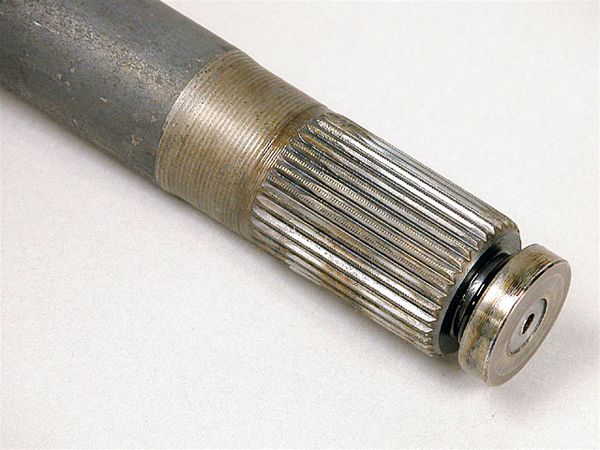 1. The 34-spline 9.75 may have one spline less and 0.070-inch less axleshaft diameter than the D60, but it makes up for it by having quality material. Ford uses a high-carbon SAE 1050 carbon steel in its axles instead of 1040. As a result, the Ford holds a significant edge over the Dana in short-term maximum output torque rating, and it's dead even in the maximum continuous rating.
1. The 34-spline 9.75 may have one spline less and 0.070-inch less axleshaft diameter than the D60, but it makes up for it by having quality material. Ford uses a high-carbon SAE 1050 carbon steel in its axles instead of 1040. As a result, the Ford holds a significant edge over the Dana in short-term maximum output torque rating, and it's dead even in the maximum continuous rating.
 2. With any axle, it's always a good idea to measure and record backlash and rotational torque before pulling the carrier for repairs or upgrades. That gives you a roadmap for proper reassembly. If these measurements change more than a skosh after reassembly, you'd better start looking for a problem...
2. With any axle, it's always a good idea to measure and record backlash and rotational torque before pulling the carrier for repairs or upgrades. That gives you a roadmap for proper reassembly. If these measurements change more than a skosh after reassembly, you'd better start looking for a problem...
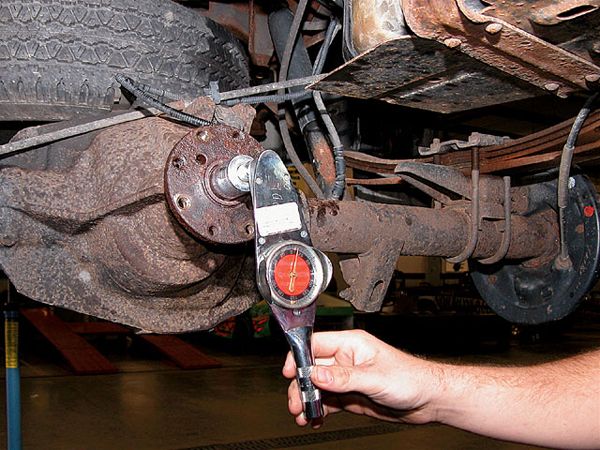 ...Total rotational torque is taken with the axleshafts removed but all other parts intact. Expect it to go up a skosh if you install new bearings and a new pinion seal. Note that the 9.75 uses a drive flange, another good design point.
...Total rotational torque is taken with the axleshafts removed but all other parts intact. Expect it to go up a skosh if you install new bearings and a new pinion seal. Note that the 9.75 uses a drive flange, another good design point.
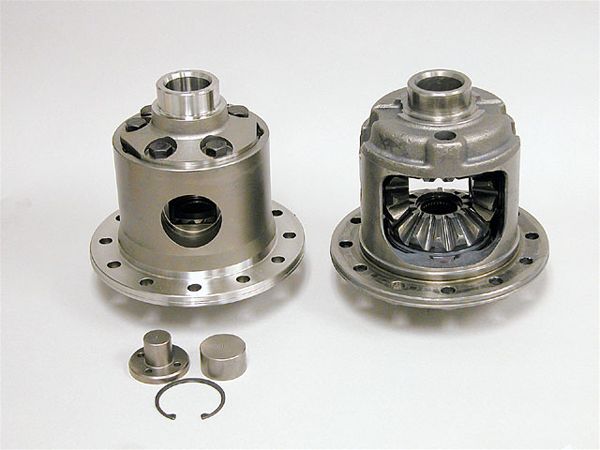 3. The new 9.75 Truetrac (left) and the OE open diff. The Truetrac has a very effective 3.5:1 bias ratio, but is almost seamless while delivering it. The Truetrac is a long-term option: No clutch plates to wear out, and no reversion back to an open diff as the factory Traction-Locks will do rather quickly. It's proven to be great in ice and snow because it doesn't have clutches that must "break away" or slip the tires when traction is low and the wheels differentiate in a turn. Rather, the Truetrac delivers smooth power all the way around a turn without breaking the tires loose. The Truetrac housing is also much stronger than the OE diff, so it also delivers in the beef department.
3. The new 9.75 Truetrac (left) and the OE open diff. The Truetrac has a very effective 3.5:1 bias ratio, but is almost seamless while delivering it. The Truetrac is a long-term option: No clutch plates to wear out, and no reversion back to an open diff as the factory Traction-Locks will do rather quickly. It's proven to be great in ice and snow because it doesn't have clutches that must "break away" or slip the tires when traction is low and the wheels differentiate in a turn. Rather, the Truetrac delivers smooth power all the way around a turn without breaking the tires loose. The Truetrac housing is also much stronger than the OE diff, so it also delivers in the beef department.
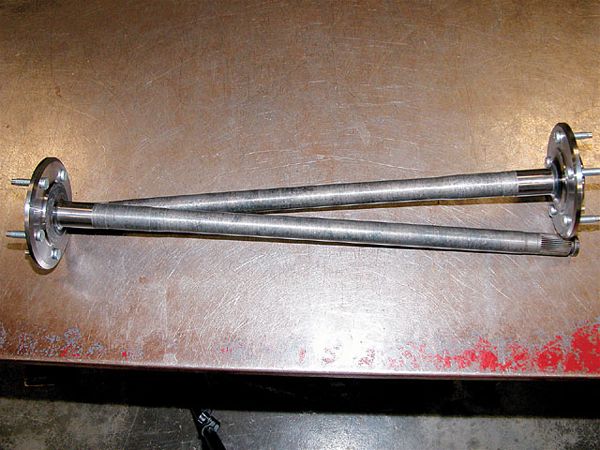 4. These beefy Yukon axles are made of 1541H alloy steel, which are only a couple of steps below chromoly in strength but much more reasonably priced. A 1541 axle is approximately 55 percent stronger than the usual 1040 axle material, and at least 15 percent stronger than the Ford OE 10.50. We also opted for Yukon's prepackaged wheel bearings and seal kit. Our '97 was the earlier unit with 1.625-inch-diameter bearing surfaces.
4. These beefy Yukon axles are made of 1541H alloy steel, which are only a couple of steps below chromoly in strength but much more reasonably priced. A 1541 axle is approximately 55 percent stronger than the usual 1040 axle material, and at least 15 percent stronger than the Ford OE 10.50. We also opted for Yukon's prepackaged wheel bearings and seal kit. Our '97 was the earlier unit with 1.625-inch-diameter bearing surfaces.
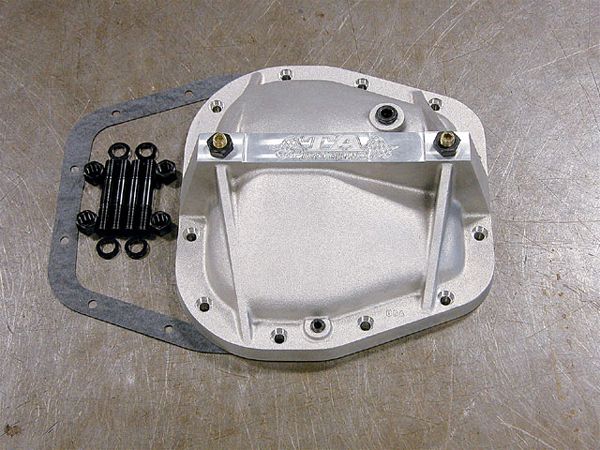 5. The TA Performance cover is a functional work of art. The two Allen-head load bolts have feet that support the carrier bearing caps between cap bolts. Under high torque loads, unsupported caps can distort. When that happens, the "pin" just got pulled on that axle's "grenade." In addition to adding a considerable amount of beef to the center housing, the TA Performance cover adds about an extra pint of oil capacity, helping the diff run cooler. The cover is complete with a drain plug and a high filler plug. We also ponied up for the optional bearing cap stud kit, which replaces the carrier bolts with aircraft-grade studs and nuts.
5. The TA Performance cover is a functional work of art. The two Allen-head load bolts have feet that support the carrier bearing caps between cap bolts. Under high torque loads, unsupported caps can distort. When that happens, the "pin" just got pulled on that axle's "grenade." In addition to adding a considerable amount of beef to the center housing, the TA Performance cover adds about an extra pint of oil capacity, helping the diff run cooler. The cover is complete with a drain plug and a high filler plug. We also ponied up for the optional bearing cap stud kit, which replaces the carrier bolts with aircraft-grade studs and nuts.
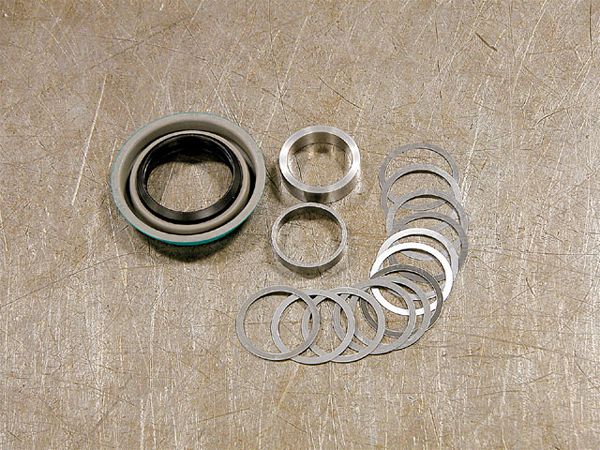 6. The Yukon crush-sleeve eliminator kit (the pinion seal is not included) replaces the pinion crush sleeve with shims. In high-stress applications, high torque loads or pinion yoke impacts on the trail can cause the crush sleeve to release the pinion preload with disastrous results. Not a common problem, to be sure, but the shims are a cheap way to add to beef and make setup a bit more precise. The earlier 9.75s had a short crush sleeve, but later ones have a long one, and the second thick spacer shown here is needed to fill the gap.
6. The Yukon crush-sleeve eliminator kit (the pinion seal is not included) replaces the pinion crush sleeve with shims. In high-stress applications, high torque loads or pinion yoke impacts on the trail can cause the crush sleeve to release the pinion preload with disastrous results. Not a common problem, to be sure, but the shims are a cheap way to add to beef and make setup a bit more precise. The earlier 9.75s had a short crush sleeve, but later ones have a long one, and the second thick spacer shown here is needed to fill the gap.
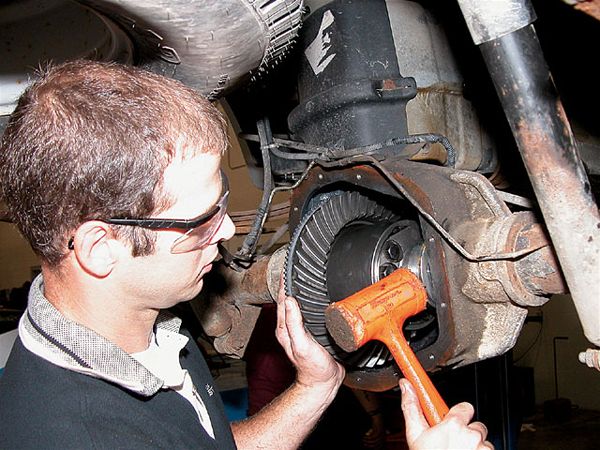 7. University of Northwestern Ohio Instructor Dave McPherson demonstrates the proper use of applied force on the carrier-bearing shims and bearings while installing the Truetrac. Installation is just the same as with any carrier. We installed new Timken carrier bearings.
7. University of Northwestern Ohio Instructor Dave McPherson demonstrates the proper use of applied force on the carrier-bearing shims and bearings while installing the Truetrac. Installation is just the same as with any carrier. We installed new Timken carrier bearings.
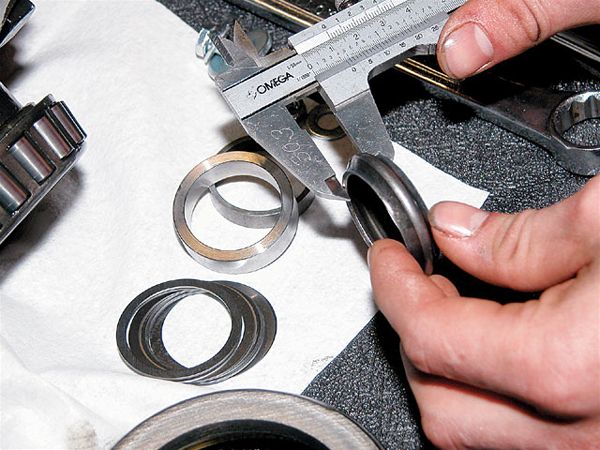 8. The 9.75 is a C-clip axle. The Truetrac has a solid spacer installed between the two shafts behind this circlip-retained cover after the C-clips are installed.
8. The 9.75 is a C-clip axle. The Truetrac has a solid spacer installed between the two shafts behind this circlip-retained cover after the C-clips are installed.
 9. The old crush sleeve (short style shown) provides a starting point for making up the Yukon shim pack. Measure the spacer and deduct 0.005 to 0.007 inch and test pinion preload...
9. The old crush sleeve (short style shown) provides a starting point for making up the Yukon shim pack. Measure the spacer and deduct 0.005 to 0.007 inch and test pinion preload...
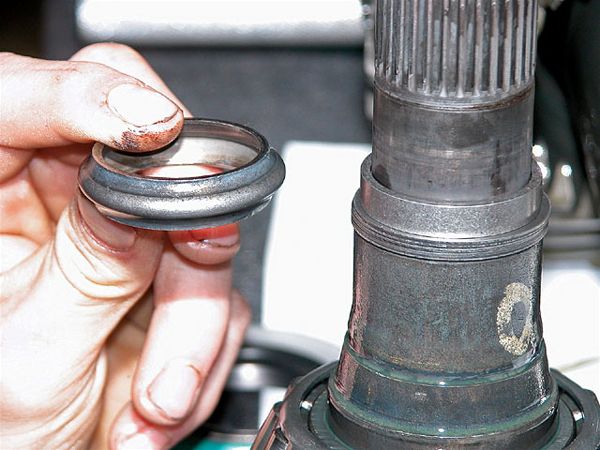 ...Add or remove shims to obtain the correct 15- to 19-in-lb preload with new bearings, or 6- to 8-in-lb with used ones.
...Add or remove shims to obtain the correct 15- to 19-in-lb preload with new bearings, or 6- to 8-in-lb with used ones.
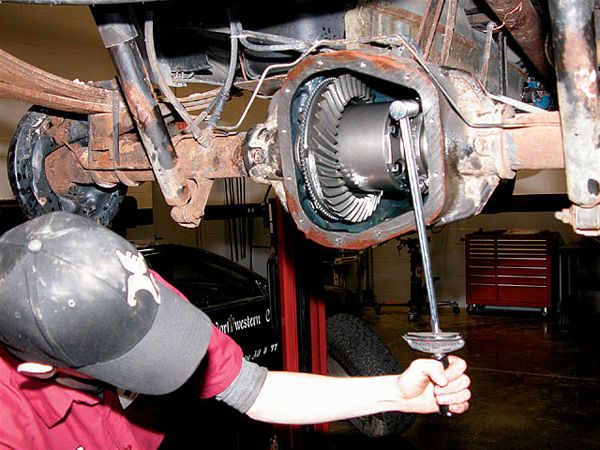 10. TA Performance offers the option of aircraft-grade studs, nuts, and washers for the carrier caps. This adds considerable strength to the axle as well. The studs are installed and tightened to 10 lb-ft (120 in-lb) and the nuts to 85 to 90 lb-ft. The factory bolts are torqued to only 70 lb-ft.
10. TA Performance offers the option of aircraft-grade studs, nuts, and washers for the carrier caps. This adds considerable strength to the axle as well. The studs are installed and tightened to 10 lb-ft (120 in-lb) and the nuts to 85 to 90 lb-ft. The factory bolts are torqued to only 70 lb-ft.
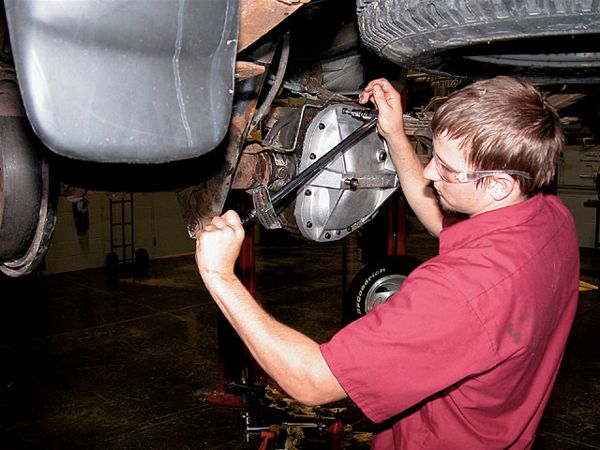 11. The TA girdle is torqued to the housing. This is important as the cover actually adds to housing strength. Next, the load bolts are run in until the feet touch the carrier caps, then torqued to 5 lb-ft (60 in-lb). The jam nuts are then tightened to the same spec.
11. The TA girdle is torqued to the housing. This is important as the cover actually adds to housing strength. Next, the load bolts are run in until the feet touch the carrier caps, then torqued to 5 lb-ft (60 in-lb). The jam nuts are then tightened to the same spec.
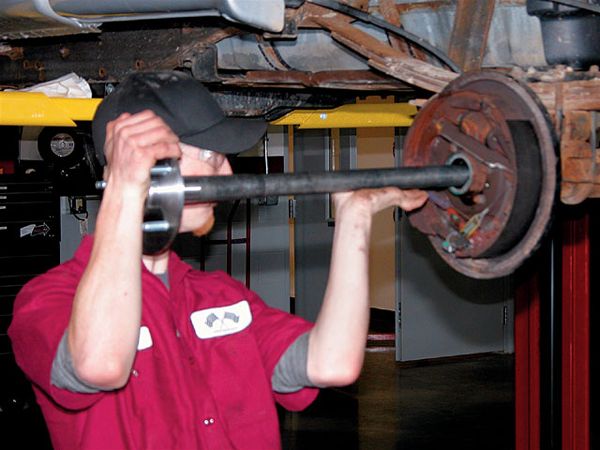 12. Installing the Yukon shafts is just as easy as the factory shafts. The big thing is to make sure you get the right shafts for your truck. To be safe, measure the area at the bearing surface. There are two possible dimensions, 1.620 and 1.705 inches, with the former generally seen on '97 and '98 trucks, and the latter on '99-and-up models. There was some crossover, especially in '99, so measuring is important.
12. Installing the Yukon shafts is just as easy as the factory shafts. The big thing is to make sure you get the right shafts for your truck. To be safe, measure the area at the bearing surface. There are two possible dimensions, 1.620 and 1.705 inches, with the former generally seen on '97 and '98 trucks, and the latter on '99-and-up models. There was some crossover, especially in '99, so measuring is important.
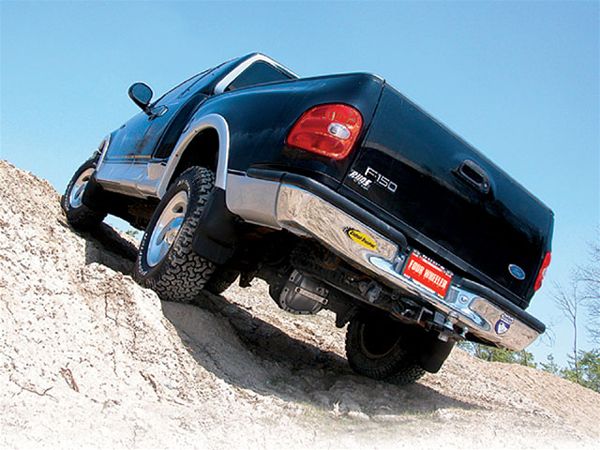 Whether climbing, towing, or engaging in stoplight shenanigans, a strong rear axle is a key element to any 4x4. The Ford 9.75 is a beefy contender to the Dana 60 semi-floater crown, and we figured out how to make it stronger.
Whether climbing, towing, or engaging in stoplight shenanigans, a strong rear axle is a key element to any 4x4. The Ford 9.75 is a beefy contender to the Dana 60 semi-floater crown, and we figured out how to make it stronger.
SPECIFICATIONS Ford 9.75 Semi Float vs Dana 60 Semi Float Axle 9.75 Dana 60 Ring gear dia. 9.75 9.75 Pinion shaft dia. 1.970 1.625 Axleshaft splines/dia. 34/1.37 35/1.50 Axleshaft min. dia. 1.29 1.36 Axle tube dia./wall 3.25/.180 3.12/.250 Output torque max 6,100 5,500 Output torque cont. 1,500 1,500 GAW 4,500 5-5,500 (Measurements in inches and pound-feet)Note: Output torque is rated two ways, as the maximum continuous and the short term maximum. Minimum diameter is usually the minor spline diameter, and that is the case on both these units.